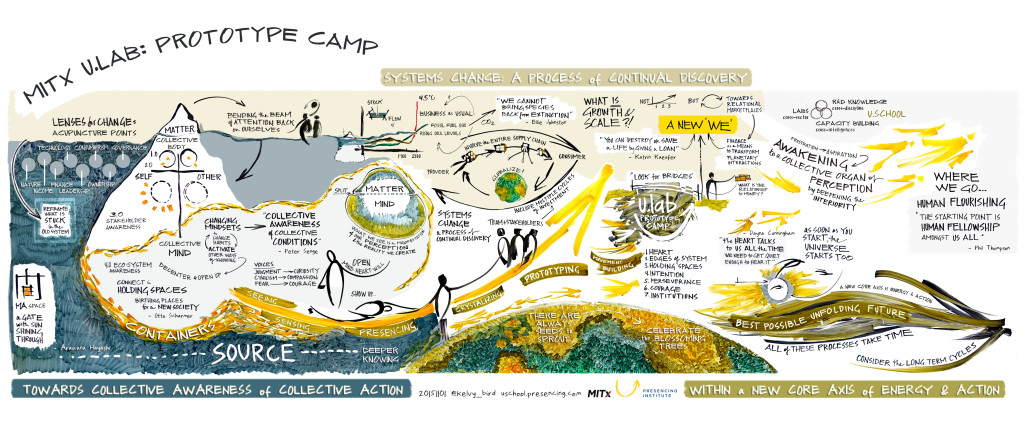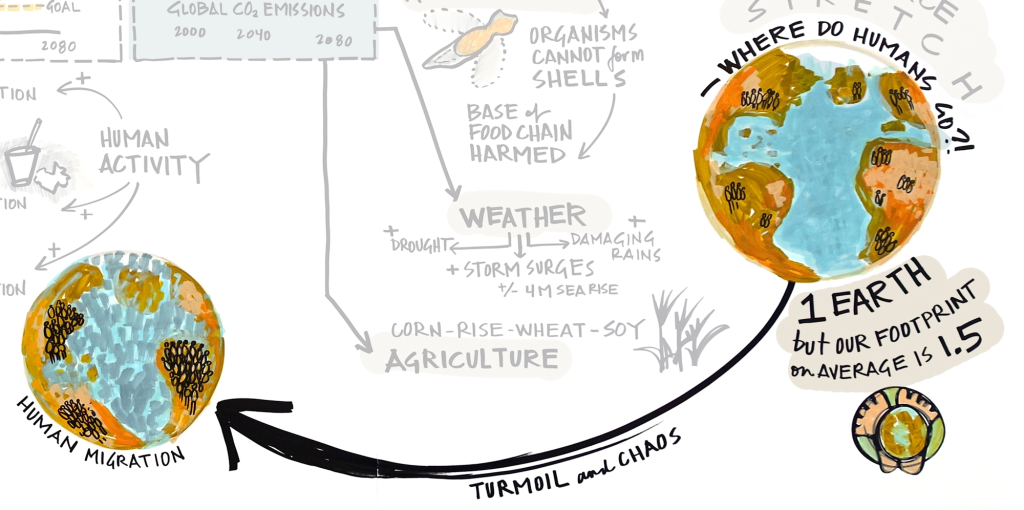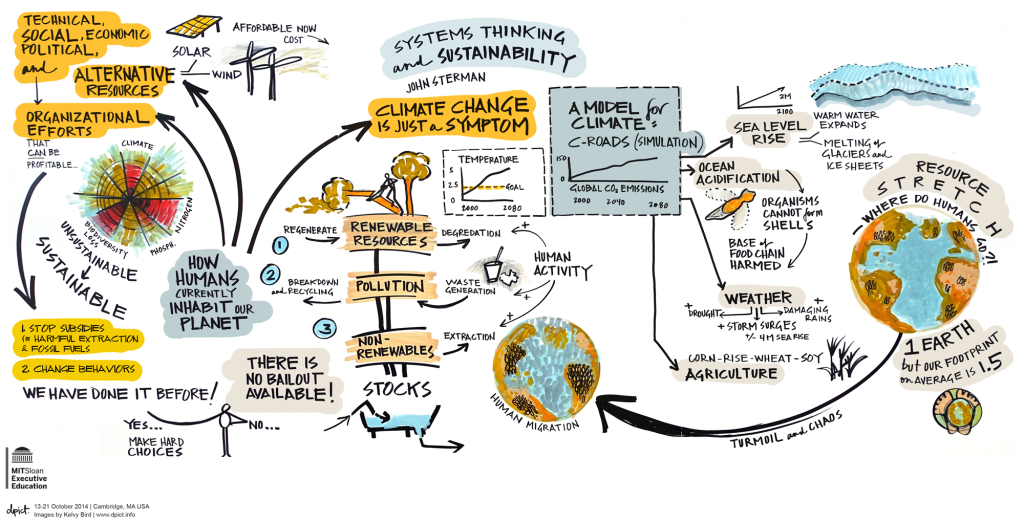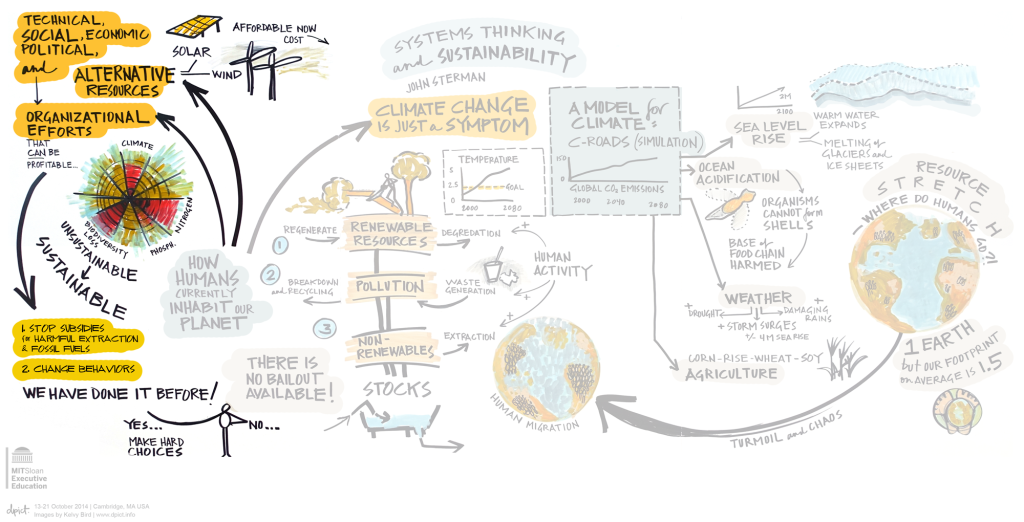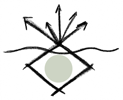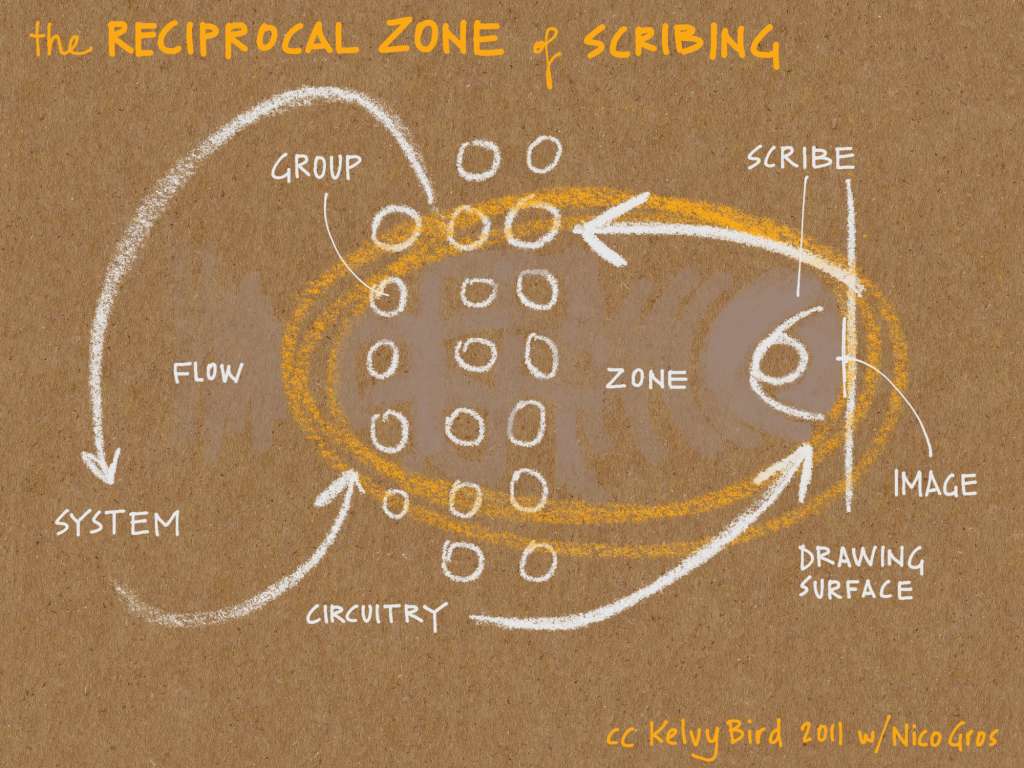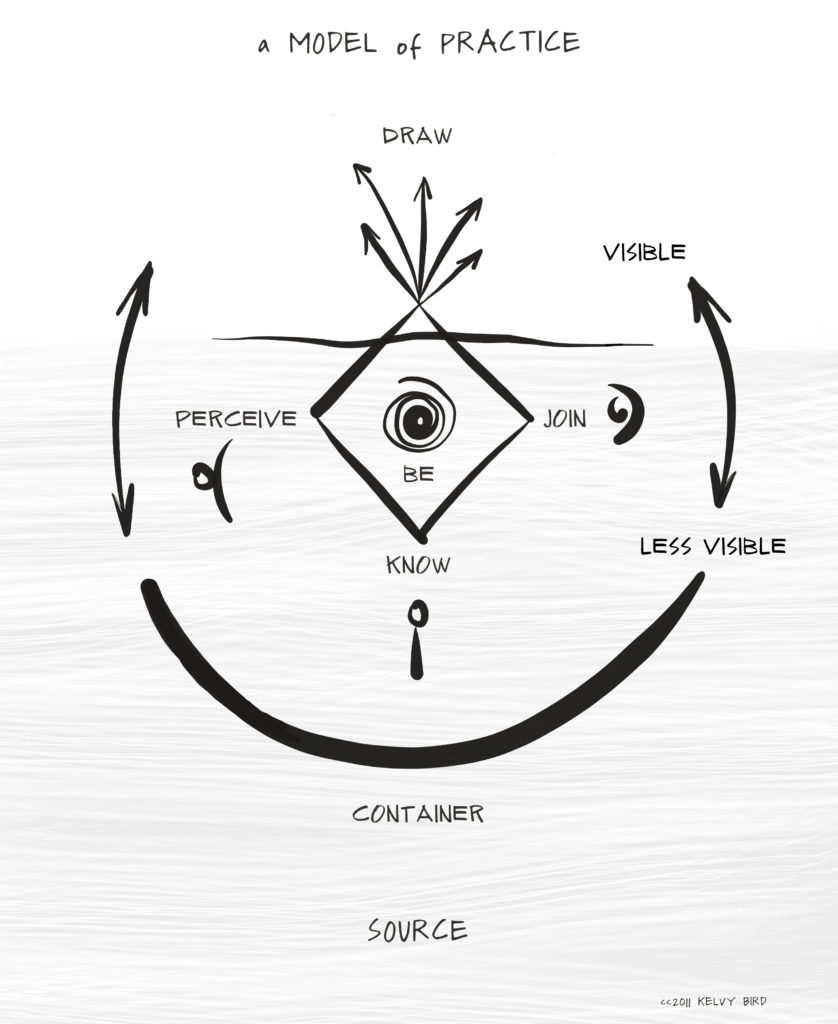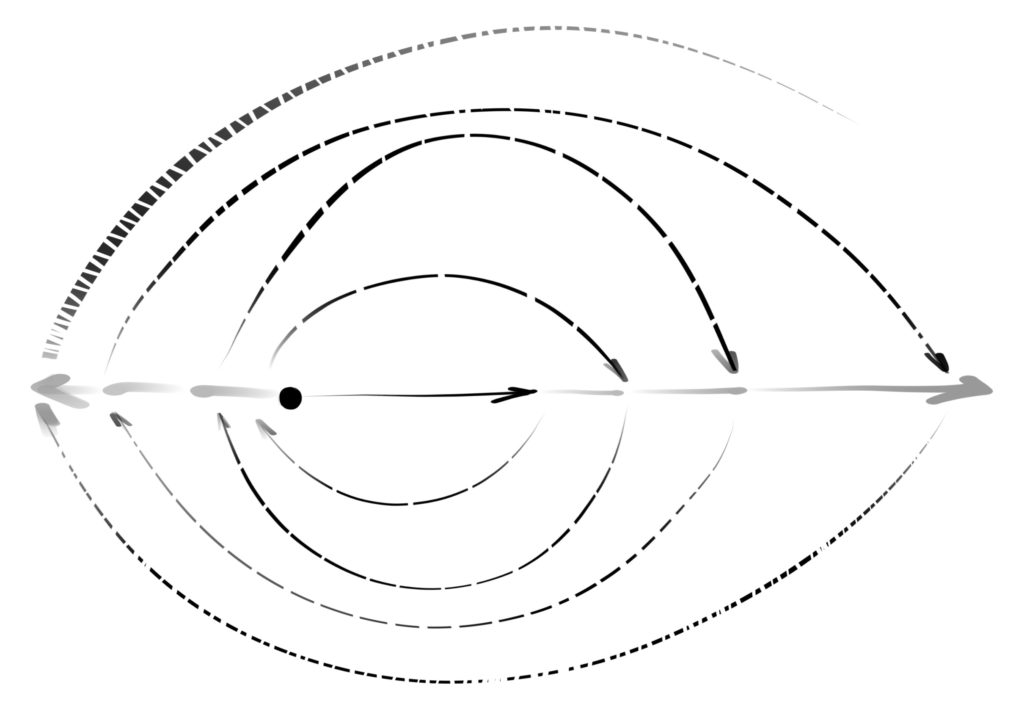20160113 Addendum – Have been doing a LOT more drawing and thinking re: iceberg since i first wrote up this post. Have shifted to think of water (oceans) as a natural key source, above that containers we humans form, and within those, the experience of icebergs. I suppose source would weave through all, including sky, at the very tip. That would make sense. Anyway – here is a drawing from late 2015 that tries to picture it. Originally ~16′, dry erase. Laid over, also, is thinking from Senge & Scharmer re: Mind/Matter split and reintegration.
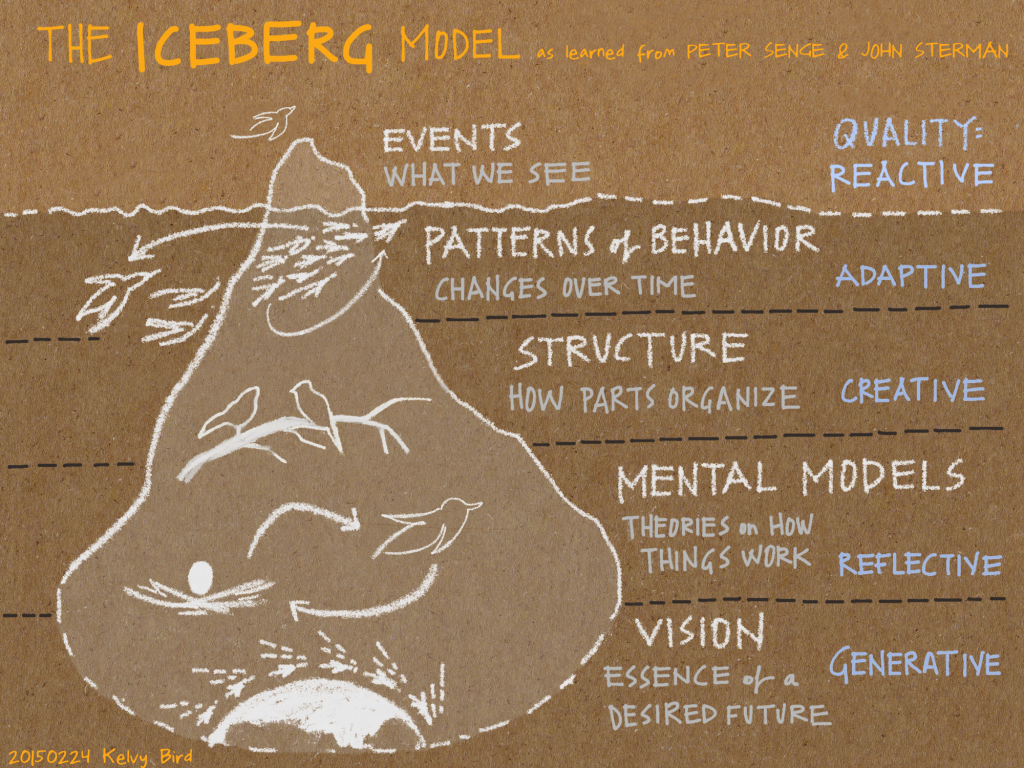
The iceberg model, used in system dynamics, is a base note to our scribing practice. To diagnose a room and reveal where sense-making of the spoken word is most needed, we can refer to these tiers: Events, Patterns of Behaviors, Structure, Mental Models, and Vision. With this framework, we surface leverage points where the system – and the scribe – can place attention to facilitate desired outcomes.
My very first step when working with an organization – of ANY scale – is to figure out where the person, panel, team, or whole group is coming from, what they are aiming to achieve, and how i might intentionally scribe to facilitate within their comfort zone and also stretch it, if possible/helpful. (See also: 4 Levels of Scribing) Usually i go one tier deeper: if they are functioning at a behavioral level, for example, i will scribe to try to reveal the structures. If that expands the boundaries of the conversation, i will tune into the mental models in play, dancing down the iceberg to create results we want all to see.
Here is a breakdown, as applied to visual practice, and clearly this is highly interpretive. (A zillion interpretations of the Iceberg are out there. Search on Peter Senge or Daniel Kim to get a feel for the origins of this thinking.)
Events
Events are like data, actual occurrences that we see, above the metaphoric waterline, like noticing a lone bird flying. In the spoken word, i think of events as individual notes – words or phrases, single statements, stand-alone ideas, comments, parts. These combine to tell stories and can be most readily represented through illustration and more literal pictures, combined with words. An example might be something like this, representing human migration:
Patterns of Behavior
Patterns convey parts moving within structures. A flock is a formation based on a need, for example, to migrate with weather. Adapted from Kevin Kelly, Out of Control, Chapter 2: “Hive Mind”:
“A bird on the fly, however, has no overarching concept of the shape of its flock. “Flockness” emerges from creatures completely oblivious of their collective shape, size, or alignment. A flocking bird is blind to the grace and cohesiveness of a flock in flight…. In the 17th century, an anonymous poet wrote: ‘…and the thousands of fishes moved as a huge beast, piercing the water. They appeared united, inexorably bound to a common fate. How comes this unity?’… A flock is not a big bird. Writes the science reporter James Gleick, ‘….High-speed film [of flocks turning to avoid predators] reveals that the turning motion travels through the flock as a wave, passing from bird to bird in the space of about one-seventieth of a second. That is far less than the bird’s reaction time.’ The flock is more than the sum of the birds.”
We can look for flock-like behavior in patterns of speech too. This occurs when one idea or person follow another, for example: “We live on 1 planet Earth, but our footprint on average is 1.5.” And then: “This will lead to turmoil and chaos, and eventually human migration.” – John Sterman (whose talk on Systems Thinking and Sustainability is the source of all these images…) The words come out with causal relation, and one concept FITS with another to form a gesture or new shape of it’s own, only a pattern because of grouping.
Structure
Structure shows how pieces of the picture form and relate. This is the land of dance, where every part of the picture holds together in a natural coherence. Connections surface across gaps, and it’s our place to organize them into an order that we perceive. We don’t look for one bird; we look for two, for three, four, forty birds and then inquire into what holds them together. Are they a couple? Siblings? Friends? Of different flocks? Adversaries? Do they face each other, turn away? Join? Avoid? Does one communicate to another bird on another branch? In another tree? What are the conditions of the tree? Protected? Exposed?
All these aspects (and many more) are components of the structure INSIDE a story, dialogue, conference theme, multi-year project. Every piece has context. Find it. Draw what is relevant to surface the inherent structure, or relationship of the parts, that wants to be revealed.
Mental Models
This is the domain of thinking and beliefs, “deeply held theories about how the world works” – Daniel Kim. This might be a more subtle territory, not at all explicit, where a deeper, almost non-verbal, listening is required to understand where people are coming from. In the iceberg drawing above, I drew an egg and a bird to represent the age-old question of “Which comes first?” that challenges our idea of where life begins.
If we take the scribed sustainability image as an example, the ENTIRE picture represents a mental model that the current climate change crisis is induced/amplified by human behavior. Some people think otherwise! But knowing (and sharing) the belief of Prof Sterman, my own mental model was very aligned with the presentation. I have also been in situations where my mental model entirely clashed with that of the presenter. Without going into detail, it required much suspension in order to be open to what ideas were being shared that i wanted to accurately represent.
This territory is fine and subtle; the beliefs are in the room and they are in us. As scribes, we are there to help represent the room, and resist layering in our own theories. That said, it is possible to help reveal biases in order to activate reflection, and, perhaps, shift mindsets.
Vision
This is the deeper territory of aspiration, hope, calling, that which can set the tone for all else pushing upward through the iceberg. I see this less as a space for projection of vision, where an aim might be set to be reached or strived for, and more as a domain of possibility, into which a scribe can sense, and then hold in spirit (even without drawing!) to really join the system as it’s future self, and share the intent for the vision to come to form through the thinking and action of the people.
Usually i leave a 1/3 to 1/4 of surface real estate for vision – it always comes, never fail. Even if faint, listen, trust in it, and you will hear it’s tune.
References: Peter Senge, John Sterman
